Buxus, or box, is an iconic hedging plant, known for its dense foliage, and stunning response to tight pruning. It makes the neatest, crispest hedge imaginable, and despite a few common problems, it’s really quite simple to grow.
If you’ve ever wanted to develop your own cottage garden, or just adore crisp boundaries, there’s nothing better to grow, and it’s not just the classic Buxus sempervirens (common box) that works. There are dozens of beautiful varieties of box you can grow, including some that display great resistance to blight.
More...
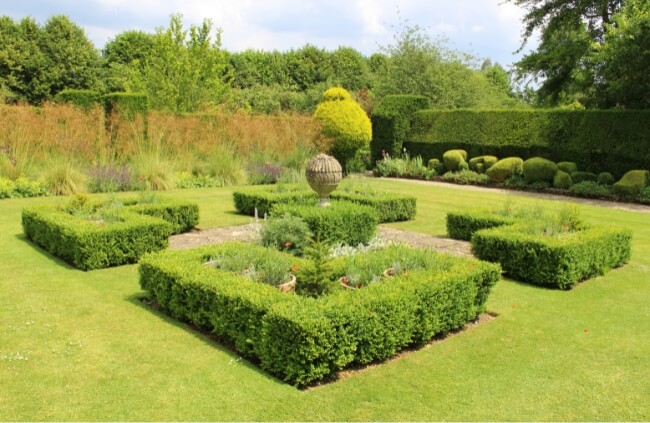
Family: | Buxaceae |
|---|---|
Genus: | Buxus |
Species: | Various |
Origin: | Europe, Asia, Africa, South America, Central America |
Common Names: | Box, boxwood |
Location: | Outdoor |
Type: | Tree or shrub |
Growth: | up to 12m |
Sun requirements: | Full sun to part shade |
Foliage Colour: | Green |
Flower Colour: | White |
Flowering: | Spring |
Edible Parts: | None |
Maintenance level: | Medium-high |
Poisonous for pets: | Low toxicity to cats and dogs |
What is Buxus?
Buxus, better known as Box, gets its name because of how incredibly simple it is to form into neat boxes formed, with crisp rectangular angles, or perfect domed forms.
As well as working well as hedging, this woody shrub can add evergreen structure to your garden in the form of domes and topiary, setting off your space even in the deepest, darkest depths of winter.
However, box blight (Calonectria pseudonaviculata) is worth getting to know, as it is spreading not just in Australia, but around the world, causing devastation for gardeners, and destroying historic hedging.
Thankfully, there are a few disease resistant varieties, which we’ve included in our list below.
How, and Why, is Buxus Used in Gardens?
Buxus is used primarily as a hedge, but can be left to develop into looser shrubs, and even trees. Topiary, whether formal, informal, tight, or messy, make great use of its tight foliage, but you’ll need to keep on top of pruning as it can leave hollows if you cut back too hard.
What is the Natural Habitat of Buxus (Box)?
Buxus, in nature, is a slow-growing evergreen shrub, with some species developing as 12m tall trees on multiple stems. At maturity they have drooping evergreen branches covered in masses of small leaves, and in spring, develop inconspicuous yellow flowers, followed by small black seeds.
12 Reliable Buxus Varieties to Choose From

1. Buxus microphylla ‘Faulkner’ (Dwarf Japanese Box )
Buxus ‘Faulkner’, sometimes called the small-leaved boxwood, is a particularly dense form of box hedging, and grows at a manageable rate. It’s ideal for topiary with tightly packed bright-green leaves that hold their colour right into winter.
As well as dense foliage, it is attractive to garden designers and commercial gardeners thanks to its dwarf habit, rarely growing more than a couple of inches a year.
2. Better Buxus Heritage
Betterbuxus® is a trademarked name for a reason, they believe they’ve developed a blight resistant box hedge. Time will tell how accurate this is across varying climates but, so far, their trials have presented a potential solution to global box blight, and a cultivar that can withstand exposure to this horticultural pandemic.
3. Buxus sempervirens (Common Box)
Buxus sempervirens, known as common box or boxwood, isn’t just one of the most commonly grown buxus plants in the world, but probably one of the most commonly grown plants full-stop.
While box blight threatens its future across the world, it is still an unbeatable hedging plant when it comes to creating low-maintenance formal hedging in any garden as it can cope with most conditions, provided it has good sun and very occasional feed.
4. Buxus sempervirens ‘Elegantissima’
This variegated box has all the charm of a Hebe, but with a much better structure. Like any other box, it’s a woody shrub, but the variegations lighten the stature of this sturdy shrub, making it ideal for any type of pruning, and particularly beautiful when pruned into a lollipop form with exposed stems, whether it’s tiered, of playfully crafted into silvery box balls.


Get Your Free Guide:
Master Growing Australian Natives eBook
A Must Have Complete Guide for Every Australian Garden
Get Your Free Guide:
Master Growing Australian Natives eBook
A Must Have Complete Guide for Every Australian Garden
5. Buxus sempervirens ‘Suffruticosa’ (Dutch Box)
Commonly referred to simply as Dwarf Box, Buxus sempervirens ‘Suffruticosa’ is one of the slowest growing box hedges you can possibly grow. In some ways that’s a curse, because it means it will either take longer to establish from young plants, or cost more to buy mature plants.
However, once established, the dwarfing habit of dwarf box makes it one of the lowest maintenance hedges around, rarely needing more than one prune in any given year to maintain its size.
6. Buxus microphylla ‘Golden Triumph’ (Golden Triumph Boxwood)
On some soil types, Buxus microphylla ‘Golden Triumph’ really is golden, but on most, it is a yellow and green variegated box, as we have found in our own garden, and will occasionally revert to having patches of plain yellow foliage.
For the picky amongst you, I would understand if that put you off, but personally, I adore the unpredictability and ever-changing tones of these stunning fine-leaved boxwoods.
7. Buxus sempervirens ‘Aureomarginata’ (Variegated Boxwood)
The common name for this board-leaves boxwood is simply Variegated Boxwood, and that’s exactly what it is. Thanks to its large leaves, the variegations are more noticeable, and build up a pattern of dappled tone and colour especially well on tightly clipped examples.
Buxus sempervirens ‘Aureomarginata’ is fairly fast-growing, so does need pruning at least twice a year to maintain any formal shapes, and will develop into a beautiful tree if left to its own devices.
8. Buxus microphylla ‘Bulthouse’
Sometimes called as Sprinter, Buxus microphylla ‘Bulthouse’ is amongst the fastest-growing small-leaved box plants. There are pros and cons to this habit, in that rapid growth means you can quickly fill out a formal hedge on a tight budget by buying young plants.
The downside is that it will require much more regular pruning, as even once established it can prude unruly growth right through the season.
9. Buxus microphylla var. japonica (Japanese boxwood)
Perhaps the most vivid greens of any buxus come from cultivars of Buxus microphylla var. japonica, which responds better than nearly all others to moisture, with plump and verdant foliage that adores any planting location provided it is paired with rich, well-drained loam.
To really boat the colour of these verdant boxwoods, apply a generous mulch of either leaf mould or part-rotted bark chippings every spring, which will not just keep weeds down, and highlight the structure of your hedge, but support healthy growth and lock in moisture through the Aussie summer.
10. Buxus sinica var. insularis ‘Nana’ (Dwarf Korean Boxwood)
Dwarf Korean Boxwood is quite different to other cultivars, and in hotter climates tends to develop quite silvery leaves. If you’re planting up a garden of mostly native plants, where silvery chromatic foliage is a key link, this might well be a simple way to unify your planting and formalise boundaries.
11. Buxus sinica var. insularis ‘Wintergreen’ (Korean Boxwood)
Another Buxus sinica var. insularis cultivar is ‘Wintergreen’, a polar opposite to Buxus ‘Nana’, which in spring and summer is a vibrant yellow-green, fading slightly to a deeper green in winter. Of all of the box hedges for year-round colour, this is probably the most sensible choice if you want that feeling of summer in the depths of winter.
12. Buxus sempervirens ‘Blauer Heinz’
And finally, something completely different; Buxus sempervirens ‘Blauer Heinz’. This blue boxwood shrub has a leaf colour more akin to cypress or Mediterranean coniferous trees and firs. I’ve seen it used countless times in some incredibly creative planting schemes and it has never failed to stun me.
Like most sempervirens boxwoods, Buxus ‘Blauer Heinz’ is quite fast growing, so it can outgrow its pruning quite quickly, but that should be embraced, as it is the slightly older foliage that holds the bluest tone.
How to Grow Buxus in Australia
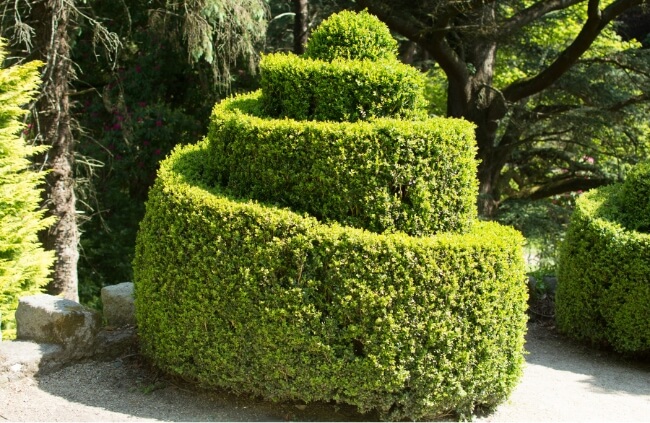
Buxus aren’t really fussy plants, provided they aren’t sat in damp soil for too long, and will tolerate a range of climates without complaint. For best results, they should be planted in well-drained but rich soil, and in full sun, with sunlight falling on every side of the plant.
For that reason, domes tend to produce the healthiest looking buxus forms, or curved hedges, where sunlight can pass over the top of the hedge.
Buxus Soil Preference
All Buxus species prefer well-drained soil with plenty of organic matter. Avoid free-draining sandy soils by adding plenty of manure, and improve clay soils in the same way, making sure to break the soil down well before adding any soil improvers.
They can grow in slightly acidic, neutral or alkaline soils, so no special soil treatments are required before planting, other than ensuring good nutrition and drainage.
Air flow
Buxus really don’t do well in humid spaces, so planting against brick walls isn’t a good idea. They should be able to breathe on all sides without restriction, so are best used as boundaries by themselves, or dotted through the garden.
Ideal Location for Planting Buxus
Buxus can tolerate part shade, and will grow in shady spots too (albeit a little slower and with less foliage) but full sun is its preference. You will notice on any buxus hedge that the side facing away from the sun will be paler, and have sparser foliage. This isn’t any fault of the gardener, it’s just the natural way that buxus develops.
By pruning the shaded side neatly once or twice a year, you encourage foliage, without the light. Otherwise, it will put all of its efforts into developing the sunny side of the hedge, and the dark side will hollow out.
To provide better light to both sides of a hedge, prune with a rounded top, or in a slight A-shape, so light can fall over the top of the hedge.
Temperature
Buxus is hardy down to well below freezing, and will cope with dry hot summers. However, in prolonged drought, regular watering will improve its appearance.
How to Plant Buxus Hedges
Before planting any buxus hedge, dig out a channel that’s twice the width of the root balls, and twice the depth. Prepare your soil, either with the addition of compost, grit, or both, and then plant your young buxus plants about 2ft apart. This gives space to develop without competition, and as they mature they will knit neatly into each other.
Note: Line channels in clay soil with grit before planting to aid drainage.
How to Propagate Buxus

Pretty much every commercially grown buxus plant is grown from cuttings. They take a long time from seed, and it’s simply not worth it. To take cuttings at home, allow a few stems to grow out beyond the main body of the hedge in spring, so you’ve got healthy material to work with.
The material you’re looking for is the young, flexible shoots, not the woody growth.
You will need:
- Horticultural grit
- Cutting compost (or sieved compost and sharp sand)
- A plastic pot
- Clean scissors
- A pencil
Method:
- In mid to late spring, once shoots have developed, cut 10-15cm pieces of young buxus stems.
- Fill a pot with cutting compost, and dib small holes all around the edge with a pencil.
- Trim each cutting to just below a leaf node, and strip all but the top few leaves.
- Drop each cutting into a hole in the compost, and water it.
- Cover the pot with a clear plastic bag, secured with elastic or twine.
- Store the cuttings in a bright spot away from direct sunlight.
- After 3-4 weeks, check your cuttings. They should have young roots developing.
- Wait another week from the first signs of root growth, and then gently tease cuttings apart, and plant into their own pots.
Caring for Buxus
Once established, there’s not much ongoing care apart from pruning with buxus. They’re simple plants, with simple desires, and in reward for regular haircuts, will offer you stunning structural form.
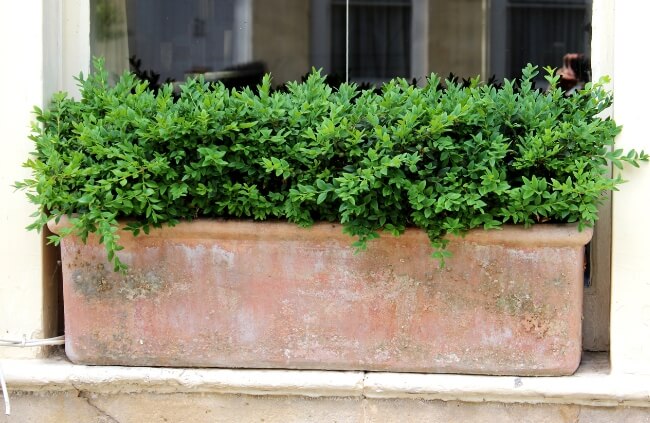
Mulching Buxus Hedges
Never mulch buxus over winter as it can trap in moisture and increase humidity, leaving your plants at more risk of blight come spring.
If you live in a particularly warm part of the country, and are worried about droughts, you can mulch your buxus with any organic materials around the base of the plant to hold in moisture and reduce the need for watering through summer.
Fertilising Buxus Shrubs
Buxus fertilisers aren’t specific, as they require very general nutrients and plenty of them.
Mulching with compost or rotted manure in spring will suffice for most, but even a standard balanced tomato food or liquid seaweed will offer quick nutrient boosts to any buxus plants, or sections of hedge that is looking a bit under the weather.
Repotting Box Plants
Buxus grows really well in pots, where it benefits from controlled moisture, and controlled drainage. A layer of grit over the soil surface helps to lock in moisture, and looks particularly lovely with neatly topiary box balls or cubes in tall terracotta pots.
Buxus is slow growing, so repotting is a rare occasion. If you notice any signs of nutrient deficiency, or roots have started to spiral around inside the pot, you can either pot your plants up, or trim the roots to revive the plant and add fresh compost before replacing it in the same pot.
Pruning Buxus Hedges and Shrubs
Buxus pruning can be easy, or it can be an art form. It depends entirely on you, and your own style of gardening. Personally, I love the simplicity of buxus domes and softly curved hedges, which take little effort to maintain.
For the more passionate topiary lover though, pruning buxus requires some serious attention to detail for the day you plant it, right through to maturity.
When to Prune Buxus
Prune buxus hedges twice a year, once in late spring as growth is starting, and once in mid-autumn, when growth has slowed down for the year.
Pruning in spring encourages side shoots and denser foliage. Pruning in late summer or autumn creates callouses that prevent outward shoots, therefore retaining the shape of your shrubs and hedges.
For precise topiary, regular but gentle pruning through summer is an easy way to maintain form.
How to Prune Buxus
Despite what many gardeners will tell you there is no right way to prune buxus. Provided you use clean tools, and don’t hack at it indiscriminately, you are very unlikely to harm the plant.
There are, however, a few wrong ways to prune buxus, dirty tools, or dirty gloves can spread infections like box blight around the garden, and cause unnecessary infection of healthy plants.
It’s also important to stay on top of your pruning. The longer you leave it, the wider your hedge will grow. And while buxus does regrow from old wood, it takes time, so if you do cut right back into the hedge to reduce its size, you’ll likely be left with quite a bare looking structure for a year or two.
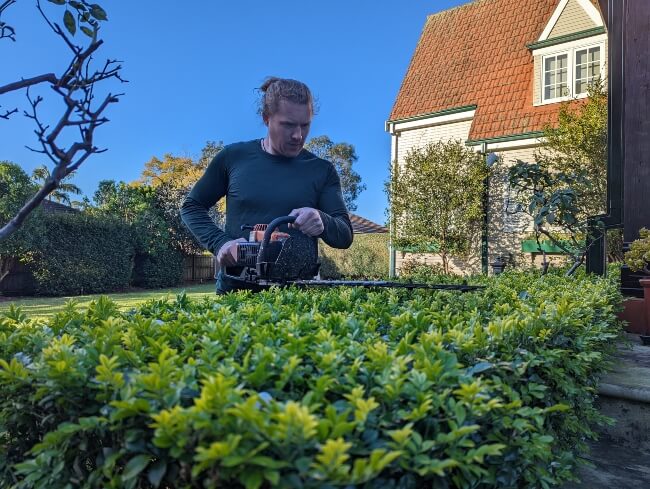
Nathan Schwartz of Aussie Green Thumb pruning a buxus hedge.
Tools for Pruning Buxus
We’ve written extensively about pruning tools, alongside some of the basic uses of each for pruning box hedging.
- Secateurs are an essential part of any garden tool kit, offering more precise control than traditional hedge trimmers, but often with a rougher finish.
- Hedge shears are the most efficient way to prune any buxus hedges, and are intuitive garden tools that help to maintain basic topiary.
- Topiary shears are more precise than hedge shears, and allow you to support growth with one hand, while working with the other. Their wide blades offer superior precision, and a much neater finish for regular pruning of crisp buxus plants.
- Loppers might seem extreme for basic hedge care, but once in a while you may need to remove a section of diseased or damaged growth, or prune out a forgotten branch that’s gone awry. Loppers are the cleanest way to make those cuts.
- Electric hedge trimmers and Petrol hedge trimmers are great for busy gardeners who need to maintain hedges quickly and efficiently. They tend to miss branches unless you work in both directions, but are essential for taller hedges, particularly if you’re working on ladders or with extending hedge trimmers.
Box Hedge Pruning Technique
Pruning box hedges is all about maintenance. That means picking a shape and sticking to it. Twice a year, cut back all new growth, to the same point. It will mean you’re left with a slightly bare-looking plant over winter, but your hedge will develop every year to take up the same space.
If you’re using hedge trimmers, create a guide to maintain a straight line, from bamboo, or wire. If you’re using hand tools, step back regularly to inspect your work, and make sure you’ve not missed anything.
Starting Topiary with Buxus
If you’re starting a new topiary from scratch, plan your plant spacing well. Do you want a single-stemmed lollipop, or a multi-stem, multi-footed creature? Plant your buxus, no matter how tall, exactly where you want it, and use garden string to connect any longer branches.
As it matures, prune against your instinct by actively slowing the growth down to produce a denser structure, taking any leading branches back by about one-third each year to encourage side shoots.
Be patient, and stick to the plan, and in a few years, you’ll begin to see your vision coming to fruition.
Common Buxus Pests and Diseases to Look Out For
There are two incredibly troubling problems with growing any species of Buxus; the Box Tree Moth, and box blight. Both cause massive amounts of damage to buxus plants, and neither is easy to prevent.
Once box tree moths find your garden, they will come back every year, and their caterpillars are incredibly hard to detect amongst the dense foliage. There are chemical controls you can use that confuse female moths and convince them to lay in bags of organic pesticide, but they’re expensive and impractical.
For box blight, there is no cure. Pruning out early signs and burning them can slow down the spread of the disease, but if it takes hold you’ll be left with withered, brown foliage, and hollow hedges.
If you have heard of confirmations of box blight in your area, consider growing native alternatives like Lilly Pilly or Grevillea.
Buxus Frequently Asked Questions
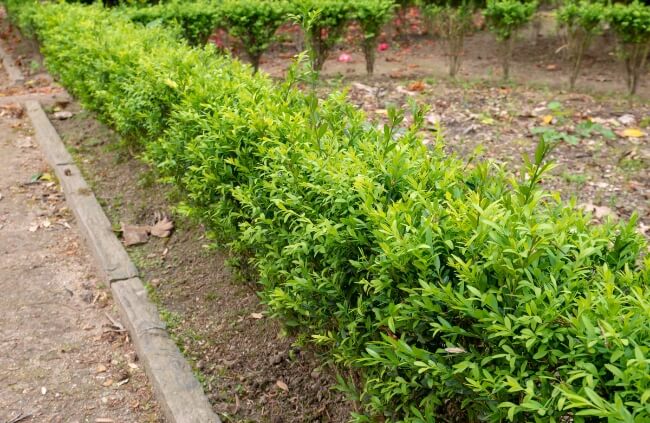
What to do when buxus turns yellow?
If your buxus turns yellow, it can be a sign of box caterpillars, but it’s often a more innocent indication of nutrient deficiency or lack of water. Check over the plant, and if there are no signs of caterpillars, and the soil is dry, water it well once a week until it recovers.
Can you feed buxus with tomato feed?
While tomato feed doesn’t contain the minerals required for buxus it does offer the right levels of nitrogen potassium and phosphorus for its basic needs and acts as a great fast-acting alternative to expensive fertilisers.
How far back can you cut buxus?
You can cut buxus back to the ground and it will re-sprout. I’m not suggesting that as a good idea, but they will regrow from the base if they have to. Best practice is to cut back to the same point each year, removing all of the previous year’s growth.
Can you over-water buxus?
Buxus don’t like wet soil, so it’s quite easy to over-water. Signs of over-watering will be crisp yellow leaves, and sudden defoliation, caused by the beginnings of root rot. This can be treated by allowing the plant to dry out and rarely causes lasting harm.
What should you do with buxus plants over winter?
Buxus is a hardy plant, so other than cutting they don’t require protection. In cooler parts of the country, protect young buxus plants from frost over winter, either with fleece or by bringing them into a cold frame or greenhouse.
Does buxus have deep roots?
Buxus roots are shallow, non-invasive roots that won’t cause harm to solid structures. Because their roots are shallow, they can dry out quickly during hot summers, so will need some irrigation to maintain reasonable moisture levels.
Wrapping Up Our Buxus Growing Guide
Buxus isn’t going to win any awards for garden innovation, and I’m not going to try to convince you that it’s even remotely exciting, but it’s part of gardening heritage and works better than any other plant as a structural form in literally any garden.
If you’ve got a wild tropical jungle for a garden, adding a few topiary box balls makes the chaos pop. For formal lawns, a boundary of buxus elevates them to a whole new level. There isn’t much that buxus doesn’t improve.
Published on October 6, 2023 by Maisie Blevins
Last Updated on November 29, 2024




